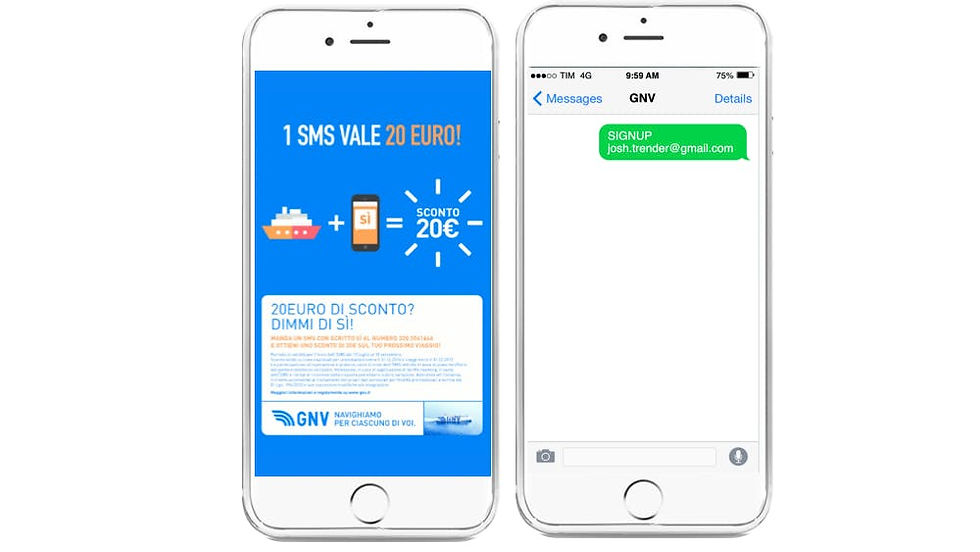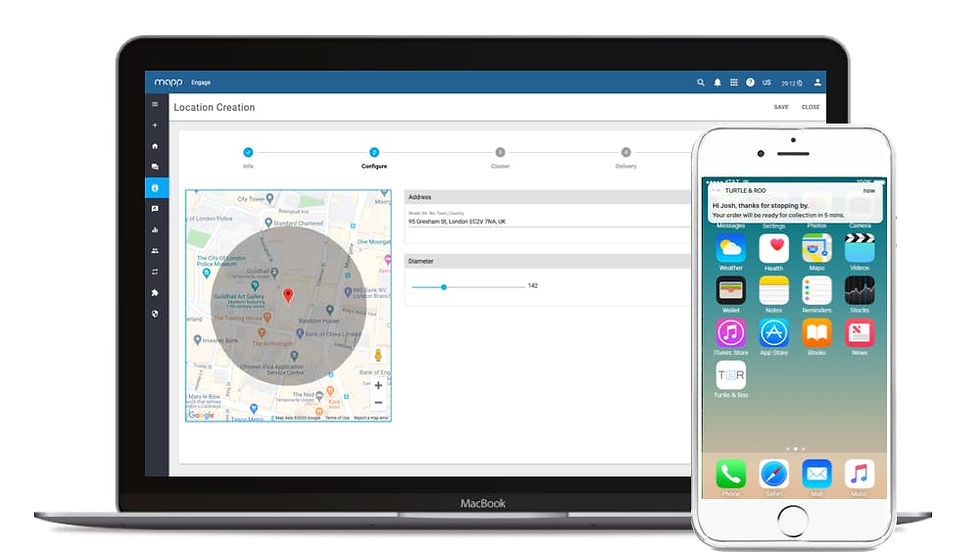Everything You Need To Know About Mobile Marketing
- Interactive Rewards

- Jan 11, 2023
- 10 min read
Updated: Feb 15, 2024

Few marketers fully understand how to leverage the full potential of mobile marketing.
Despite its popularity, brands often struggle to execute successful strategies that can help them keep up with shopper behavior, as they hop between multiple offline and online channels.
Done well, mobile marketing empowers you to capture shoppers’ attention with short and impactful messages. These make the customer experience so convenient and personal, that purchasing becomes frictionless and sales are easy to achieve. And with shoppers glued to their phones 24/7, it’s the perfect way to contact them wherever they are, enabling you to achieve optimal marketing reach.
But it’s an important strategy to get right. Google found that mobile users are 62% less likely to purchase from brands that provide negative mobile experiences. And it’s all too easy to unintentionally deliver sub-par experiences, especially as mobile marketing is essentially a line to your shopper’s most personal devices. As a result, common mistakes like over-messaging and heavy marketing pressure can damage trust, lower engagement, limit sales, and increase opt-outs.
Read on to learn how to execute mobile marketing the right way to improve your customer’s omnichannel experience with your brand.
TABLE OF CONTENTS
How powerful is mobile marketing? Biggest mobile marketing mistakes Know the “Omni-channel web” 4 Steps to successful mobile marketing Mapp Cloud: Mobile marketing capabilities
HOW POWERFUL IS MOBILE MARKETING?
Mobile marketing makes a fast impact, and these catchy communications can even go viral! In the best-case scenario, that means lots of eyes on your brand for the right reasons. But, if you get it wrong, going viral for poor messaging can damage your reputation long-term. Considering that it’s such a risky strategy, why should you pay extra attention to getting your mobile marketing right? The statistics speak for themselves:
Eyes Straight on Your Messages: People check their phones around 58 times a day, meaning customers will see your messages fast – whether it’s content, notifications, or ads.
Access to The Leading Device for Online Traffic: The days of desktops and laptops being the only link to the web are over. Now, mobile devices rule online, accounting for 99% of web traffic. By neglecting them, you’ll miss the opportunity to catch shoppers on the devices that they use most.
Multiple Channels Centralized for Optimal Marketing Reach: A cross-channel mobile marketing strategy gives you the options you need to reach your customers in the most effective way. With many channels centralized on one device (email, SMS, and more), you can interact with customers where they’re most likely to open messages and convert. After all, marketing across three or more channels results in a 494% higher order rate than a single-channel approach!
But here’s the best advantage of them all. Reaching shoppers on mobile devices results in high engagement because they are personal objects that people keep close. They’ll stop in their tracks to check notifications, whether relaxing at a bar or rushing to a work meeting. And now that more people are working from home, you’re even more likely to catch them checking their phones between work calls!
This is why mobile marketing is a powerful marketing strategy. It can boost key performance indicators like engagement and conversion rates, while its convenience fosters an effortless customer experience. But be careful about knowing the line between useful updates and over-messaging, as you don’t want to accidentally force excess marketing pressure on mobile users.
MISTAKES THAT WRECK THE BENEFITS OF MOBILE MARKETING
Lacking an insight-led mobile marketing strategy can damage your relationships with mobile users because their devices are so personal. One spine-chilling example is that sending more than five push notifications a week causes 64% of people to quit your app.
Customers aren’t fans of being bombarded with messages. They also don’t like you alerting them with irrelevant and generic information, especially if it’s repeated across multiple marketing channels. These aggravating mistakes cause poor customer experiences and tank sales.
So how can you ensure your mobile marketing campaign will strengthen customer relationships and drive sales? The answer is to place actionable customer insights at the core of your overall omnichannel marketing strategy using a strong bank of consolidated real-time customer data. Yet, many brands make the mistake of basing strategies on incomplete profiles of customers because data is siloed across many standalone marketing platforms.
A customer data platform (CDP) can unify your data points and structure these into unified customer profiles enriched with real-time first-party data. It cuts the time marketing teams need to get to know shoppers and discover how, where, and when to send effective communications. That means you can send eye-popping messages on the best channel at an ideal time to drive your customer engagement.
KNOW YOUR CHANNELS IN YOUR “OMNICHANNEL WEB”
You can reach customers on their mobile devices in several different ways. Each has a unique set of characteristics and requirements that affect whether it’s the right channel for you and your customers to bridge together.
SMS

Short Message Service (SMS) is the technology that allows people to text on mobile phones. It’s a mobile-only channel with a 55% open rate.
But there’s a catch. To enjoy the benefits of SMS marketing, you need to respect your customers’ wishes at all times. No one wants to be woken up by a 5AM text about a generic sale. With that in mind, always ask permission before sending an SMS to a customer. This also means that SMS campaigns are limited to customers whose details and permissions you have.
It’s also important to remember that customers can’t opt out of SMS easily (unless you offer the option in the text), so low-quality messaging will frustrate and annoy them. Instead, send short, personalized texts containing information shoppers want. For example, let them know about a sale at their local store the day before it starts, to boost footfall!
You can also strengthen relationships by offering time-sensitive and relevant deals or essential information like delivery alerts. Additionally, SMS allows you to quickly reach shoppers to invite them to opt in to competitions and communications. But it’s important to tread carefully, as every customer has a marketing pressure threshold. Going over this will give the customer every reason to opt out and never look back.
All in all, SMS marketing is a sensitive but easy-to-run campaign that lets you send important updates immediately. That’s especially useful if you don’t have an app, but it can be costly at scale. But if you do have an app, you need to remember that you can’t trigger SMS messages from your app, as it functions on a separate channel.
SOCIAL MEDIA
Social media is a key mobile marketing channel. For instance, 80% of Twitter’s traffic is mobile-based. You’ll make the most headway by advertising and retargeting on the sites your target audience prefers. But don’t forget to keep an active profile that your audience can easily find on all the heavy-hitters such as TikTok, Twitter, and Instagram for your social media presence. That’ll ensure mobile users can find you easily and validate you as trustworthy.
LOCATION-BASED MARKETING

Bringing the online and offline worlds together, location-based marketing is an excellent tool to drive footfall to your stores. In fact, 86% of companies find that location-based marketing boosts sales and grows their customer base.
This channel works by pinpointing your customers’ locations using technology such as satellites and Bluetooth. Once you have that information, you can use geofencing to send messages when shoppers are in a significant area, for example, near your stores, in-store, or even close to competitor stores. Reaching out with exclusive discounts and offers will drive footfall to your brick-and-mortar sites and give you an opportunity to upsell with the power of the in-store sales model.
IN-APP MARKETING
Apps have become many companies’ digital storefronts. They’re an excellent instrument for communicating with your customers, promoting purchasing, and capturing data. And you can use them as a form of digital marketing by sending in-app messages to customers while they browse. These messages are powerful and highly likely to be read, with a 39.88% open rate.
In-app marketing offers unique opportunities. For example, you can use it to guide your shoppers to app highlights and provide customer service such as live chats. Another remarkable feature of in-app messaging is that it doesn’t need a call to action because the mobile user is already browsing and checking out your store. That also makes it a bit less risky because customers already have free time and interest in your products.
Because you already have shoppers’ attention, it’s also a good fit for welcome messages and promotional offers.
The downside, however, is that you can’t use app-based messages to draw customers back to your stores. Instead, it’s a valuable way to communicate alternatively with people who use your app but opt out of SMS and push notifications.
Here’s the biggest plot twist of in-app marketing: customers can’t opt out of in-app messages because they function like website popups. So when shoppers are already onsite, consider optimizing the customer experience with personalization and ensuring your content looks great on every device. And keep your messages up-to-date and relevant to avoid frustrating app users!
PUSH NOTIFICATIONS

Push notifications are notifications sent to customers’ mobile devices through apps that show up on their lock screens or notification panels. They’re a fast and direct channel for talking to customers.
This mobile channel improves customer engagement, retention, and lifetime value. But just like SMS, it can be intrusive. So, you must personalize messaging and consider timings.
Ensure your push notifications always include a call to action that draws customers to your app. And consider using rich messaging, which includes gifs, audio, and video to make messages pop. After all, adding a single emoji can increase app open rates by 85%!
For the best results, send automated messages after specific actions to improve relevancy and guide mobile users back to buying, for example, after a customer abandons their cart.
You can even offer incentives such as a 5% discount to encourage shoppers to complete their purchases.
Delivering push notifications has many advantages: it’s cheaper than SMS while still being immediate, links to your app, and is a direct channel to treat VIP customers to exclusive offers. You can also reactivate inactive users and encourage sign-ups without mobile users having to check your app. But, there are downsides, such as their low open rate and the fact that customers can easily opt out.
Email is integral to digital marketing, but you might not think it’s a channel for mobile marketing strategies. Yet, people open 61.9% of emails on mobile devices, so appealing to mobile users is critical. Keeping that in mind, you must deliver a mobile-optimized marketing campaign if you want people to see your emails. But before thinking about that, you need to consider email deliverability.
Email deliverability is the likelihood your emails will reach shoppers’ inboxes rather than the dreaded spam box. One factor that affects deliverability is audience engagement — ignoring over half of your subscribers risks poor open rates that plummet your domain credibility and leave your emails gathering dust in the junk folder.
To keep messaging mobile-friendly, send short, punchy messages and grab attention with images, videos, and gifs.
4 STEPS TO A SUCCESSFUL MOBILE MARKETING STRATEGY
UNIFY YOUR CUSTOMER DATA
Do you ever wonder who your new or existing customers are and what they like? This lack of knowledge means you probably aren’t armed with enough data to deliver mobile marketing experiences that convert. Alternatively, the problem may be that you’re not consolidating your data to develop a 360-degree view of your customers.
A customer data platform (CDP) will help you run successful mobile marketing campaigns by unifying your customer data and enriching it with more GDPR-compliant first-party data. It will combine the puzzle pieces from every channel to form a single source of truth: unified customer profiles. Once you can see your customers clearly through a single source of truth, you have the knowledge to execute a successful marketing strategy.
SEGMENT YOUR CUSTOMERS
Unified customer profiles give you the building blocks for segmentation. Segmenting is the process of separating customers into groups to target communications. You can group customers by various attributes, such as their favorite channels, interests, preferences, demographics, and more.
Additionally, you can dive deeper and combine data from multiple marketing channels to provide customers with the most relevant experience. For example, only message men aged between 18-25 when they click an email link and visit a set area of your website.
DELIVER PERSONALIZED AND RELEVANT CONTENT
Empathy is a key part of every marketing campaign. But you need shedloads to avoid poor mobile marketing. Every message must have value, be relevant, and tell readers something they want to know. Think exclusive sale alerts, back-in-stock notifications, similar items, and discounts on products they’ve viewed.
Customized content will speak directly to your customers and encourage them to take action. If you’re unsure how to personalize messaging so that it converts, Mapp Cloud has ready-to-go templates to help you deliver personalized communications fast.
USE CUSTOMER INSIGHTS TO AMPLIFY CROSS-CHANNEL COMMUNICATION
An effective CDP will transform your customer intelligence into communications that convert by giving you the strong customer understanding you need. It’ll allow you to understand the times shoppers are active, the channels they use, their devices, their browsers, and much more. It all depends on your data analytics solution and whether it integrates into your CDP.
Consolidating your tech can help you seamlessly interact with your customer at the right moment. Mapp Cloud offers a CDP, marketing automation, and customer intelligence for you to launch insight-led experiences. It puts your customer insights at the core of your marketing and executes automated campaigns to help you contact audiences on the right channel, at the right time, and with the right frequency.
MAPP CLOUD: MOBILE MARKETING CAPABILITIES
Mapp Cloud is an insight-led customer experience platform with a native mobile channel designed to deliver revenue-boosting mobile marketing strategies. We’ll give you the key to launching successful campaigns: actionable insights that are based on real-time customer behavior.
Our intuitive platform enables you to unify, visualize, and activate your data to develop unified profiles of your customers. Use these insights to personalize not only your content, but the overall experience of each interaction. Our easy segmentation based on a range of categories enables you to create customized messaging and automatically trigger communications on the right channel, such as SMS (with geo-targeting), push, or in-app notifications.
Our tracking and analysis empowers you to learn about your mobile users behaviors in a GDPR-compliant way and visualize the performance of your mobile marketing in our powerful marketing analytics dashboards.
This article was first published by Mapp. Permission to use has been granted by the publisher.

.png)



Comments